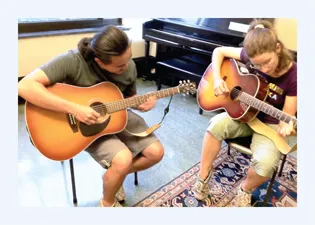Chapter 1: Learning to Play
You’ve chosen to start off on a musical adventure: playing the guitar. Let’s take a look at some of the facets of the instrument and the different musical options it offers. I’ll also show you how to create a practice plan and pursue your guitar playing into the future.
Hit the Ground Running
Continue Your Guitar Education
Some Final Advice Before You Start
Hit the Ground Running
Compared to other instruments, the guitar is a relatively easy instrument to learn. You can play it from the first day, using a few simple chords. You’ll be playing in just a few pages!
Start Playing Today
Violin and trumpet students have to practice diligently for years to play a major scale with a warm tone in tune. While the guitar will eventually make its intricacies known to you, you can learn the first three chords (see Chapter 6) and a simple strumming pattern (see Chapter 9) on your first day. The frets, which divide the string length, do the job of keeping you in tune, and you’ll play simple rhythms until you develop more coordination. Although you’ll eventually want to reach higher levels of proficiency, you can start creating music right away!
Set Goals for Yourself
The trick to teaching yourself anything is to practice on a steady schedule and to set realistic goals. Give yourself time to learn, and don’t get discouraged if things don’t come to you immediately.
People often become their own worst enemies when learning a musical instrument because they set unrealistic goals. Remember that mastering an instrument is a learning process that is both mental and physical. You understand what you have to do, but training your hands takes time. Allow your body to develop muscle strength and memory, which are slower to develop in an adult. You will eventually develop those skills, so don’t lose patience!
Practice the Right Way
Develop a reasonable but steady practice regimen. Try to practice every day, if only for 15 or 20 minutes. If you can’t practice every day, try not to put your guitar away for several days in a row. Make sure you’re playing at least every other day. Leave the guitar next to the TV or somewhere else where you’ll see it often, and let your hands get used to the instrument in your spare time.
Starting and stopping your guitar playing will only make the process more discouraging. You will probably progress more quickly than you realize or give yourself credit for. Be prepared to work through the rough spots. Your efforts eventually will be rewarded!
Keep the learning experience fun by playing songs you love. Doing so will take the “work” element out of practicing, and you’ll master the skills you need before you know it!
Continue Your Guitar Education
Now that you’ve started your musical journey with the guitar, you’ll want to find ways to pursue your playing. Here are some options to consider as you use this book as a reference.
Work with a Private Teacher
After you’ve worked on some of the basics, you might seek the guidance of a private instructor. You can work with a teacher on individual playing issues and specialize in different types of music.
Nothing can replace the inspiration and clarity that come from working with a professional musician. Use this book as a resource while your teacher helps you focus on specific issues. He or she can design a special program of songs and exercises to take your playing to the next level of proficiency.
Learn from Other Guitarists
Part of the beauty of music is the interaction and sharing you experience when playing with others. Learn from your friends as you use your guitar as an outlet for musical communication. Continue the learning experience by playing with other musicians who are slightly more experienced than you are. You’ll gain guidance and inspiration, as well as ideas about what to pursue in your independent studies or with your instructor.
Also play with friends who are beginning guitarists like you. Realize that some of your friends might learn certain things faster than you; don’t worry about it or compare yourself negatively to them. Every guitarist finds certain tasks easier than others. Your friend may find it easy to play barre chords, but find it difficult to play finger-style guitar as well as you do. Everyone’s development differs from skill to skill.
Some Final Advice Before You Start
Remember to set realistic goals for yourself. Don’t set your standards so high that if you don’t meet them, you get discouraged and give up. Muscle strength and muscle memory don’t develop overnight, but with consistent practice you will develop them eventually.
Practice, Practice, Practice!
Practice is most effective when it is regular and consistent. Practicing for half an hour a day is better than cramming in a four-hour session once a week. Muscles and reflexes need a regimen to stay sharp. If you know you won’t be able to practice every day, then try to play every other day. If you’re taking lessons, try to practice a little right after you meet with your instructor. Doing so provides a great chance to ingrain what you have learned while it is fresh in your mind.
Work on Different Skills
As you continue to learn new skills, including different fretting techniques, lead guitar, and different rhythmic approaches, you may find that certain ones are harder to master than others. Don’t let work in one area stop you from working on skills in other areas. For example, don’t feel that you have to master barre chords before you experiment with lead guitar. You may find that you have a knack for vibrato and string bending, but your index finger muscles may need to develop some strength before you can perform these skills competently.
Finally, don’t forget to have fun! Don’t let technical goals obscure the reason you picked up the guitar in the first place.
Chapter 2: Parts of the Guitar
All guitars have similar essential features. Before you start playing, let’s take a look at the different parts of the electric and the acoustic guitar.
Parts of the Acoustic Guitar
Parts of the Electric Guitar
Headstock and Tuning Pegs
Neck
Body
Bridge
Strings
Electric Guitar Controls
Parts of the Acoustic Guitar
Let’s get acquainted with the most common parts of the acoustic guitar.
Parts of the Electric Guitar
Now let’s look at the parts of the electric guitar. Some of them are similar to the acoustic guitar, while other components—especially those involving electronics—are diffe...







